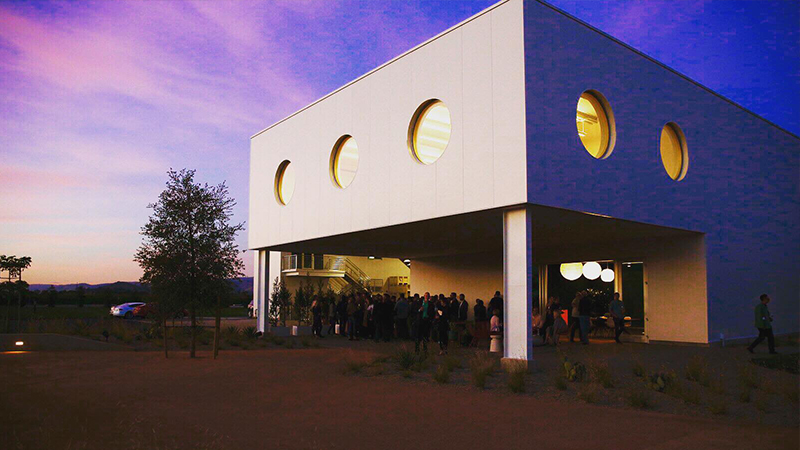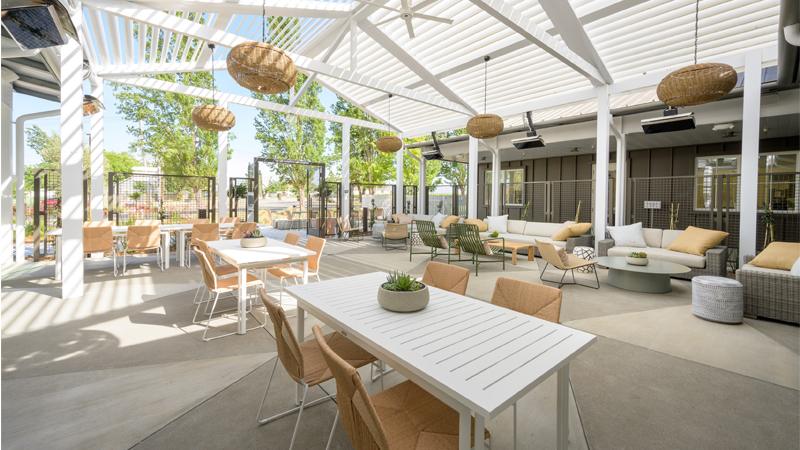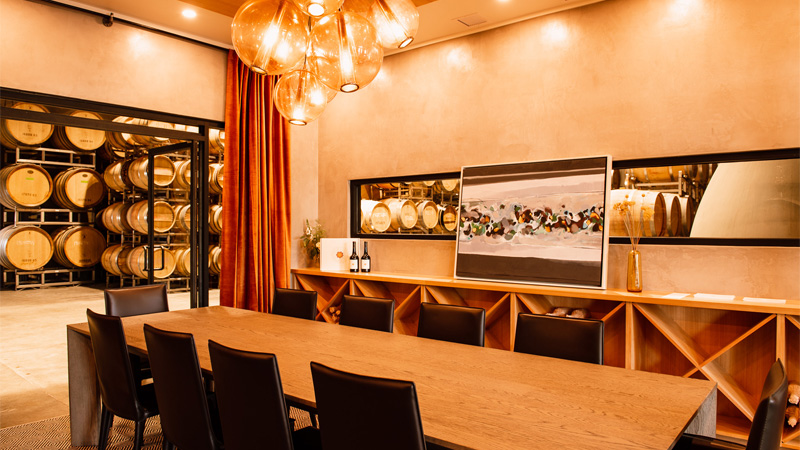When Kashy Khaledi opened Napa Valley’s Ashes & Diamonds in 2017, he didn’t set out to create a winery that would appeal specifically to millennials. There was just something about the winery’s hip, mid-century modern design — foregoing the neutral “greige” color palette and heavy leather sofas that have become ubiquitous in recent years — that struck a chord with the under-40 crowd. Now, other wineries are looking to capture the same magic that’s inspired some to call Ashes & Diamonds “a magnet for millennial wine lovers.”
“If we set out to pander to a certain subset it would be disingenuous, and I’ve done that before,” says 44-year-old Khaledi, a former creative director at Live Nation and Capitol Records. “I worked at places like MTV that were governed by data mining and focus groups. With Ashes & Diamonds we knew going in that the place would need to reflect our approach to winemaking — classic California wines inspired by the mid-century.”
Sonoma’s Scribe Winery has also been a major draw for millennials since the winery opened for visitors in 2010, and it gained an even bigger following in 2017 with the renovation of the property’s century-old hacienda building. The revamp, which resulted in increased visitor traffic and winery memberships, thoughtfully married historic elements from the structure’s past, such as cracked walls and peeling paint, with contemporary furniture, clean lines, and light hues.
Don’t miss a drop!
Get the latest in beer, wine, and cocktail culture sent straight to your inbox.
“It felt really inauthentic to make the hacienda feel like a certain period,” says Scribe co-founder Andrew Mariani, who founded the winery with his brother Adam. “We approached the renovation with a philosophy that we weren’t going to try to fake anything. Our architect, Dave Darling, worked with all the layers of eras and chapters of this house, and now we’re adding our own contemporary layer.”
As a millennial himself, Mariani says he and Adam didn’t specifically design the space and experience to appeal to their own generation. They just did what they thought would be fun and interesting. “We try to make everything really transparent and real,” he says. “We were just trying to do something that honored the history of the place and felt authentic.”
At a time when winemakers are looking for ways to lure younger consumers away from cocktails and hard seltzer, the aesthetic at wineries such as Scribe and Ashes & Diamonds is inspiring other producers to step up their games with design-forward tasting room revamps and new construction.

Instagram-Ready Design
One of the hallmarks of this new era of tasting room design is sunlight. “A lot of the wineries used to be dark inside, almost cave-like,” says Douglas Thornley of Goring & Straja Architects in Berkeley, Calif., who began designing California winery spaces in 1998. “You’d often see winemakers take a glass of wine outside and hold it up to the sunlight to look at the color. This told me they needed to have more natural light.”
Thornley put this theory into practice in 2009 with the design of the Cuvaison tasting room in Napa-Carneros, outfitted with massive sliding glass doors that blur the lines between indoor and outdoor spaces while letting in plenty of light and showcasing panoramic vineyard views. At the time that it was unveiled, this was a major departure from the dimly lit faux chateaux and Tuscan villa designs favored by many wineries.
Now he’s working with Cuvaison to expand the exterior terrace and create two VIP pavilions that extend out over the winery’s irrigation ponds, similar to boat docks. The idea, Thornley says, is to provide many different tasting spaces where guests can hang out with friends and have a different experience each time.
“What we’re seeing with the millennials is that they’re sort of looking for the Instagram shot,” he says. “If you’re at a cool place and you take that really fun picture, it will go viral and people will want to go there.”
Creating “Instagrammable” moments was almost certainly on the minds of the Duckhorn Wine Co. team with the design of the Migration tasting room in Napa, which opened this year on Memorial Day. The winery is a polished, modernized rendition of a farmhouse, with sunny indoor-outdoor spaces, a light color palette, and contemporary, minimalist furniture. Proving its youthful appeal, Migration recently hosted a group of 20- and 30-something influencers for the launch of Duckhorn’s Decoy wine-based seltzer.

“We wanted the space to reflect the breezy natural beauty of Carneros wine country, with an emphasis on an open, airy environment that invites the outside in,” notes Carol Reber, Duckhorn’s executive vice president and chief marketing officer. The tasting room has an enclosed and secluded all-season patio and features a VIP room, and two interior alcoves for intimate sit-down tastings.
“Tasting rooms continue to evolve as they play an ever-more pivotal role in building lasting relationships with wine enthusiasts,” says Reber. “People want to visit tasting rooms that are beautiful, but they also want them to be warm, welcoming places where they can relax, bring their dog, and laugh with friends.”
Similarly, the tasting room at The Walls in Walla Walla, Wash., was designed for hanging out and slowing down. Owner Mike Martin purchased the winery building from vintner Charles Smith in 2016 and took advantage of pandemic downtime in 2020 to completely revamp the dark, cramped space.
“With the new design we’ve dramatically changed the winery,” he says. “By knocking down walls and adding more windows, it’s much more of an open, modern space.” Paneled with blond wood and accented with creamy paint colors, the tasting room has an upscale lounge feel, with mid-century-style arm chairs and sleek sofas upholstered in plush orange fabric.

Large glass panels have replaced the winery’s solid entry doors, and visitors entering the building can now see straight through to the barrel room and production facility. New glass doors open into the barrel room, which includes a seated tasting area among the winery’s large oak foudres.
The new design also features an outdoor patio inspired by the Chateau Marmont hotel in Los Angeles, outfitted with stylish high-back wicker chairs and sofas that help create a sense of space and privacy. “People can have their own group of six or eight,” Martin says, “and be sitting next to another group and not feel like they’re on top of each other.”
While The Walls already had a solid following of younger consumers before the remodel, Martin says he’s already seeing an increase in millennial visitors thanks to the fresh new look and experience.
“I have noticed a steady flow of people under 40, which, to me, is just great,” he says. “We love everybody, but we particularly love to see the future.”
This story is a part of VP Pro, our free content platform and newsletter for the drinks industry, covering wine, beer, and liquor — and beyond. Sign up for VP Pro now!


